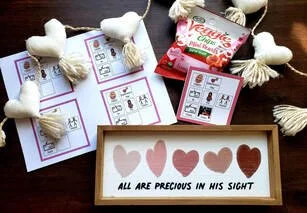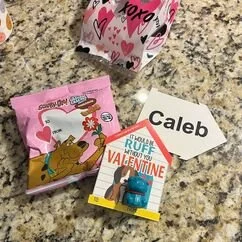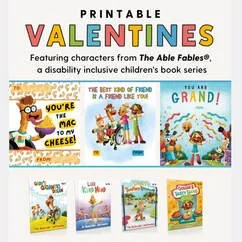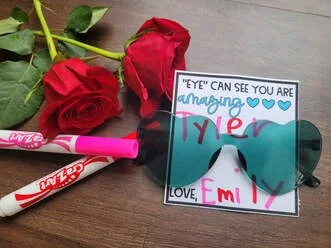Valentine’s Day
Valentine’s Day is around the corner. I personally loved decorating my box with all sorts of pink and red construction paper and stickers and drawings. In addition, I'll admit to saving a special Valentine card for my secret crush and overanalyzing whether or not that person would crack the code depending on which card I gave him. ;)
Now that I have kids, I have enjoyed picking back up the tradition of making Valentine’s cards. The excitement and fun is contagious! Getting Valentine's cards really allows me to tap into my creative side.
When my daughter, Haley, started attending school, I wanted her to have similar opportunities as her siblings and peers. This perspective also challenged me to think of other ways we can all be inclusive when celebrating holidays. I am excited to share a handful of ideas for inclusive Valentine’s cards that you can use yourself or with your own kids.
1. Haley uses an alternative and augmented communication device (AAC) to communicate. We are using Valentine’s Day as an opportunity to share with her peers how Haley communicates so that they can learn how to communicate with her better. This year, like years in the past, Haley and I created Valentine's Day cards using the "language" Haley uses daily to communicate her Valentine’s wishes to her friends.
2. Another way to adapt your Valentine’s card is by using an alternative “pencil.” Some individuals find writing challenging and so they type, gesture, dictate or use other methods to “write.” Haley’s friend, Caleb (Amy’s son), uses a name stamp to “write” his name on his school papers and Valentine’s cards. The stamp provides Caleb independence and allows him to actively participate at school and during other activities/events (like Valentine’s Day).
3. The next idea we want to share to promote an inclusive Valentine’s Day is the use of Valentine's cards with diverse and inclusive designs. Research shows that when students are introduced to disability in a positive way, it raises awareness and minimizes fear and stigma of disability. The Able Fables offers FREE inclusive Valentine's cards that can be downloaded immediately. Both students with and without disabilities can use these cards.)
4. Valentine’s Day is a holiday that is often celebrated with food and sweet treats. If a child has food allergies or dietary restrictions, those items can feel exclusive. We recommend that you consider other options such as small toys, crayons, sunglasses, seeds (to grow flowers), fidget toys and more!
Happy Valentine's Day! We hope you have been inspired over the past week to get creative and find ways to help make Valentine’s Day inclusive for everyone.💗
We would love to hear your favorite idea we shared or see a picture of your Valentine's in the comments below.
ABOUT THE AUTHOR
Allison Huffstutler, one of the Co-Founders and Co-Executive Directors of BRIDGED, has degrees in both education and counseling. As a parent of a child with a disability, she has over a decade of experience as an advocate and ally of the disability community.




